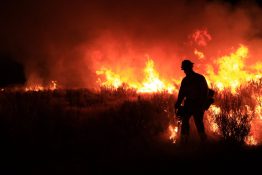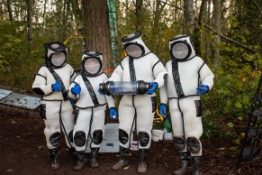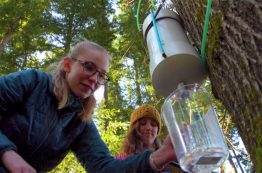As its name suggests, the bigleaf maple tree’s massive leaves are perhaps its most distinctive quality. A native to the Pacific Northwest’s wet westside forests, these towering trees can grow leaves up to 1.5 feet across — the largest of any maple. But since 2011, scientists, concerned hikers and residents have observed more stressed and dying bigleaf maples across urban and suburban neighborhoods as well as in forested areas.
Read more at UW News »Dryer, warmer night air is making some Western wildfires more active at night
Firefighters have reported that Western wildfires are starting earlier in the morning and dying down later at night, hampering their ability to recover and regroup before the next day’s flareup. A study by University of Washington and U.S. Forest Service scientists shows why: The drying power of nighttime air over much of the Western U.S. has increased dramatically in the past 40 years.
Read more at UW News »Citizen scientists and the fight against the Asian giant hornet
Hornets the size of golf balls may seem like something out of a sci-fi movie, but unfortunately as one Marysville, Washington resident learned, they are real and living right here in western Washington. On June 4, the first Asian giant hornet of 2021 was reported to officials in Snohomish County. The sighting was the farthest south this invasive species has been reported since it was first discovered in 2019 in British Columbia.
Read more »Researchers discover yessotoxins, produced by certain phytoplankton, to be a culprit behind summer mass shellfish mortality events in Washington
Back in the summers of 2018 and 2019, the shellfish industry in Washington state was rocked by mass mortalities of its crops. “It was oysters, clams, cockles — all bivalve species in some bays were impacted,” said Teri King, aquaculture and marine water quality specialist at Washington Sea Grant based at the University of Washington. “They were dying, and nobody knew why.”
Read more at UW News »Tasty options as researchers tap a new forestry product
Scientists from the University of Washington are testing the viability of making maple syrup in the Pacific Northwest. Long associated with Canada or Vermont, this sweet forest product that has graced many a breakfast table may be part of this region’s future. Washington maple syrup is made from the watery-looking sap of bigleaf maple trees, one of the most abundant native hardwood trees in the Pacific Northwest.
Read more at UW News »





